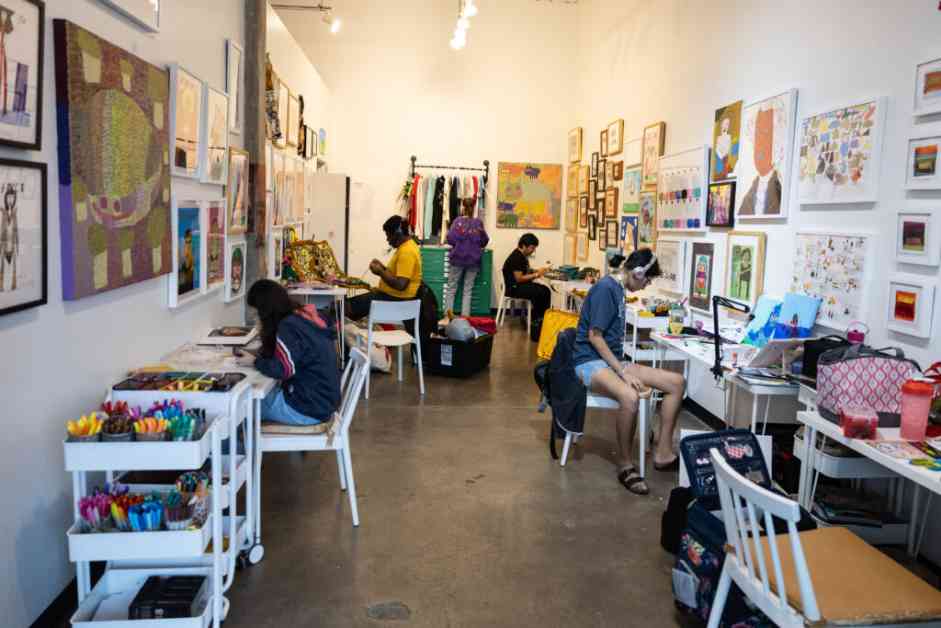When I sat down to chat with Molly Hale, she had spent part of her morning pushing pieces of string through a small wooden loom. “I am working on a tapestry, weaving out of different types of threads,” she said. “It just comes randomly what I want. I got three done over there and I also add charms to them.” Hale is an artist who produces work at SAGE Studio & Gallery, an organization in East Austin that supports and shows the work of creators with developmental and intellectual disabilities.
“My mom is my big advocate,” said Hale. “She got me into all the fiber art stuff. She taught me when I was 13 years old and I am actually 41, so I’ve been doing it ever since.” Like many studios, SAGE is not just a location where people produce art. It’s a place where creatives find community. Hale is not originally from Texas and, according to her, the transition to living in the Lone Star State was difficult. “It took a long time to cope,” she said, “but I suffered enough and I’m mostly thinking on the bright side of things than on the wrong side of things. I found a couple of good friends here actually in SAGE.”
First founded in 2017, SAGE is not a day program where people with disabilities simply make friends and learn social skills. It is a studio and gallery space that is looking to make a name for itself and the artists it represents. “To date, we’ve paid over $200,000 in commissions to our artists,” said Director of External Relations and cofounder Lucy Gross. “We have artists that earn upwards of $30,000 a year from their art sales.” Artists at SAGE work with a wide range of materials like paint, pastels, colored pencils and fibers. When an artist sells an original work, they keep half of the final sale price. The other half goes to SAGE.
“We’re constantly looking for new opportunities for our artists,” said Gross. Since its inception, SAGE has done collaborations with companies like Vans, Whataburger and Austin FC. One of their goals is to help artists with disabilities break into and build careers in the mainstream art world. “My hope is that we can sort of evolve to where we’re just showing art,” said Gross. “Whether that art is made by artists with or without disabilities, that’s kind of moot.”
SAGE Studio & Gallery is a self-styled progressive studio. These are organizations dedicated explicitly to cultivating and promoting the work of artists with intellectual disabilities. Progressive studios have been around since at least the late 1970s and any attempt to come up with an exact count of how many there is an exercise in futility. “It’s been really challenging to pinpoint a specific number,” said Cléa Massiani. Massiani is an independent curator and a Ph.D. candidate at the University of Maryland. She is currently working on a dissertation about the history and role of progressive studios.
“I have counted over 80 studios across the country at the moment,” she said. “I’m sure by the end of my dissertation, I’m going to get to at least 90.” By Massiani’s count, California, New York and Illinois are the states with the most progressive studios. Texas has at least seven. Part of what makes creating a definitive list impossible is that “progressive studio” is still not a widely understood term in the art world. “There is a clear lack of scholarship, so a lot of people are not even aware that they are in existence,” explained Massiani.
One of the leading efforts at raising awareness of progressive studios is Disparate Minds, a project that has tracked, written about and highlighted the contributions of artists with disabilities since 2014. “There is more connectivity among studios than when we started,” said cofounder Andreana Donahue. “A lot of us know each other.” This relatively small movement is still establishing itself, but there have been some recent breakthroughs in visibility. In December of 2024, the Museum of Modern Art New York City featured the work of Marlon Mullen, a painter who works out of the progressive studio NIAD Art Center in Richmond, Calif. In conjunction with Mullen’s exhibition, MoMA added the term “progressive art studio” to its list of art terms on the museum’s website, a move that advocates view as helping legitimize their cause. “I’ve been working in this field for over 10 years so I’ve been able to witness the continued convergence with the mainstream contemporary art world,” said Donahue.
Montrel Beverly first started making art out of pipe cleaners in third grade when he had a teacher who incorporated them into a math lesson. After the class was done, Beverly asked for permission to play with some of the leftover pipe cleaners. “I made a Sonic figurine. It wasn’t the best-looking thing, but I loved it,” Beverly reminisced. “Sadly, the next day when I went to grab it, a janitor threw it away.” Beverly attends SAGE Studio & Gallery four times a week and when he first started coming, he spent most of his time making figurines of anime, cartoon and video game characters. “I like making silly things and stuff like that,” he said. “Basically I kind of have like a kiddish brain.”
Beverly has worked with pipe cleaners for more than a decade and in recent years, the scope of his work has expanded. Since joining SAGE, his work has been displayed at more than a dozen exhibitions. His favorite was a solo exhibition hosted at SAGE called “Go To Your Room.” “Basically my solo show was a teenage room in the ’90s and ’80s,” said Beverly. “I made Rock ‘Em Sock ‘Em, Hungry Hungry Hippos. I made old classic snacks like the Lunchables Deluxe.” At the time I interviewed Beverly, he and other studio artists at SAGE were preparing for an upcoming show called Friends Fair, a three-day event hosted at the Loren Hotel in downtown Austin.















